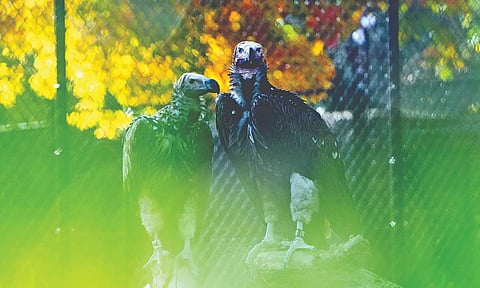

By Natalie Angier
NEW YORK: The two lappet-faced vultures had been together for just a few months, yet the massive birds, with their watchful, featherless gargoyle faces and their dark mottled body plumage so plush it looks like fur, had already mastered the avian version of monkey-see-monkey-do.
Kenya, the female vulture, hopped onto a tree stump in the middle of their outdoor enclosure at the Maryland Zoo. Shredder, the male vulture, hopped onto another stump nearby. Kenya jumped back to the ground. Shredder waited a beat and did likewise. He lumbered over to a corner of the enclosure and spread his wings wide to their nearly seven-foot span, exposing fluffy white feathers that covered his legs like a pair of bloomers. Kenya positioned herself a few inches behind him and added novelty to the mimicry, unfolding first one wing, then half of the other, then the second half: Ta-da! It’s called mirroring behavior, Jen Kottyan, the zoo’s bird curator, said, and it was a promising sign. Lappet-faced vultures, native to Africa and named for the flaps of skin, or lappets, that dangle from either side of their head, are among the world’s most endangered birds. In 1991, the Maryland Zoo became one of the first in the United States to successfully breed the vultures in captivity, and Ms. Kottyan predicted that the newly installed pair, now 2-and-a-half years old, would prove similarly obliging.
“They’re doing really well, and they seem to get along,” she said. “So we’re hoping things will go easy when they hit sexual maturity in another three or four years.” Brandon Jones, an animal keeper who worked closely with the vultures, threw the birds a piece of raw meat. They ripped it apart and swapped pieces of it back and forth.
“I think she’s a little smarter than he is,” Jones said. “All vultures are smart,” Ms. Kottyan said. “I haven’t met a vulture that wasn’t.” To the general public, vultures may seem vaguely repulsive, Edward Gorey-type characters that skulk in bare trees waiting for something to die. But to researchers who study any of the 23 species in today’s vulture consortium, the birds brim with intelligence born of their exceptional vocation.
Many animals feed on carrion opportunistically, when the occasion arises. Alone among vertebrates, vultures have taken scavenging professional. In lieu of hunting live prey, they seek out dead meat. That may seem easy — after all, everything dies. But because the time and place of an animal’s death are rarely predictable, the vulture’s reliance on carrion has forged, along with a flexible neck for poking into corpses and a featherless head for easy self-cleaning, a creative, cunning and wide-ranging mind.
“It makes sense that an animal that depends on scarce resources can really benefit from being intelligent,” said Thijs van Overveld, a vulture researcher at the Donana Biological Station in Seville, Spain.
Vultures, their fans insist, rival the famously brainy parrots and corvids in the use of tools and artful maneuvers to secure their needs and desires. Egyptian vultures, for example, have been shown to throw stones at ostrich eggs to crack through the shell, but only after an experimenter revealed to the birds that the giant eggs contained food. Egyptian vultures have also been observed wielding twigs to rake up tufts of wool from sheep shearing pens and repurposing the wool as nest insulation.